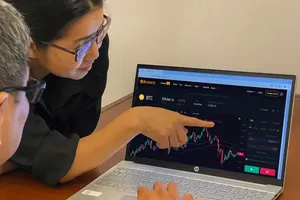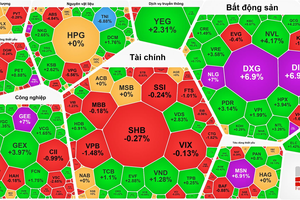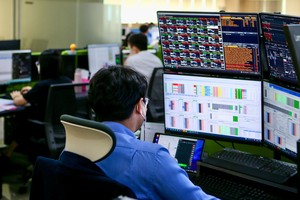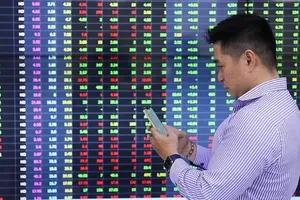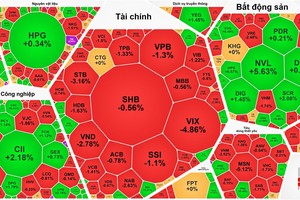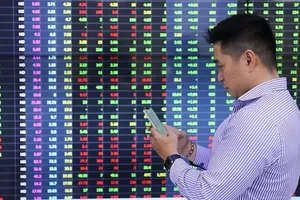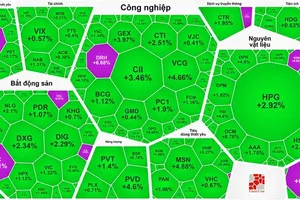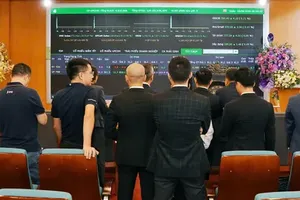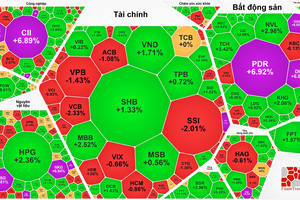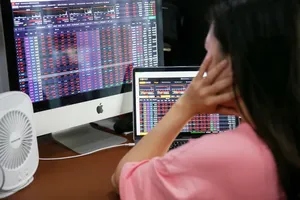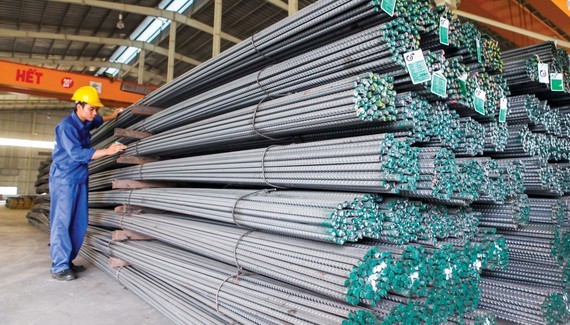 Photo: Long Thanh, SGI
Photo: Long Thanh, SGI
Dual benefits
During the first months of the year, steel consumption grew strongly compared to the same period last year due to high demand in export markets and also because of the recovery of the domestic construction industry. Finished steel products and consumption in the first quarter, including for construction steel, pipe steel, and galvanized steel sheet, reached 4.6 million tons, up by 18.2%, and 4.4 million tons, up by 21%, respectively. The biggest increase in export volume was in the galvanized steel sheet sector, while the domestic market promoted the consumption of hot-rolled coil (HRC), construction steel, and steel pipes.
According to Viet Dragon Securities Company (VDSC), recovering construction activity and rising steel prices supported construction steel demand from retailers. Specifically, the construction industry growth reached 5.2% in the first quarter, higher than the growth rate of 4.4% in the same period in 2020. The recovery of construction activities in many countries also helped increase steel export output by 12.3% over the same period in the first months of the year.
Steel enterprises also benefited from the recent high increase in steel prices. Specifically, steel prices surged in March and April with the highest increase up by 45%. According to the Vietnam Steel Association (VSA), the domestic steel supply is not scarce, as the price increases due to strong increase in dependence on production materials in the world. Specifically, the price of iron ore as of early March was over US$ 170 per ton, up by 55% compared to the end of 2020, and double than in the same period last year.
Steel prices are forecast to increase until the end of the third quarter due to scarcity of input materials from China and India. Analysts forecast that the price of standard iron ore could rise to US$ 200 per ton, breaking the record of US$ 194 per ton, set ten years ago. The reason is that steel mills in China are increasing production sharply, despite the government control measures to limit carbon emissions by the steel industry. China's demand has further tightened the global iron ore market, as the market has not really recovered from the supply shock that occurred two years ago. There is an opinion that iron ore prices may go higher in the short term, even surpassing US$ 200 per ton.
Increase in profits
For steel enterprises, the first three months of the year were successful, especially for downstream flat steel manufacturers, due to strong growth in sales of galvanized steel and steel pipes. Consumption of galvanized steel increased by about 50%, of which export volume increased by 134%. Most of the major manufacturers are operating at full capacity in their galvanizing steel mills, including Hoa Sen Group JSC (HSG), Nam Kim Steel JSC (NKG), SMC Trading Investment JSC (SMC), Hoa Phat Group (HPG), and Tien Len Steel Joint Stock Company (TLH).
The increase in sales volume and selling price has helped steel enterprises to record a sudden increase in profits in the first quarter. For example, HPG became the leading enterprise in terms of profit on the stock market with more than VND 7,000 bn, up three times over the same period. After a long period of difficulties, HSG suddenly joined the group of trillion enterprises, with a profit of VND 1,035 bn, up five times over the same period. NKG and SMC also recorded profit growth, and even TLH increased by 30 times over the same period. Recently, TLH announced business results in April with consolidated profit after tax of VND 115.3 bn, equivalent to VND 116 bn profit in the first quarter.
On the stock market, steel stocks were also leading when many stocks reached historic peak. For example, HPG surpassed the mark of VND 63,000 per share and became the third largest market capitalization stock on the stock market, only after Vingroup (VIC) and Vietcombank (VCB). At this time last year, SMC and HSG were still trading below par, but now they have skyrocketed to around VND 40,000 per share. The most prominent is TLH from just over VND 2,000 per share to more than VND 20,000 per share. Huu Lien Asia Joint Stock Company (HLA), although not yet out of loss, still increased four times, at now VND 200 per share.
Hidden risks
Investors put high expectations on steel stocks because of excellent business results just announced by enterprises. However, this is only a short-term benefit, because if the price of raw material continues to increase, steel enterprises will be at a disadvantage when cheap inventory of raw materials is no longer available. According to a leader in a steel enterprise, the price of raw material increases a number of times, while the price of semi-finished products can only increase by about 50%. Normally, businesses buy raw material for each quarter, but now they have to buy raw material until the fourth quarter. Although the risk is high, businesses must accept buying to ensure continuous production. This shows that steel production is not really as per expectation of investors.
Steel enterprises have to bear the risk of high raw material pricing, as well as face a lot of pressure from management agencies because their production activities cause serious environmental pollution. At the end of April, HPG new steel plant in Dung Quat in Quang Ngai province was put under strict environmental control. According to Mr. Nguyen Hung Thinh, Deputy Director-General of Vietnam Environment Administration, the investigation by authorities determined that the Hoa Phat Dung Quat Steel Factory was causing environmental pollution since the beginning of 2021. It is worth mentioning that this project is being promoted by HPG using advanced, modern, and green technology, producing coke coal by dry coke stamping technology, completely recovering heat and emissions, and making full use of by-products to generate electricity. The entire production water source is also used for circulation, and not discharged into the environment.
The high price of steel also has a negative impact on the economy. According to a construction contractor, the increase in steel prices affects signed contracts, causing the estimated budget to exceed, leading to loss. Although the investor knows the difficulties the contractor is facing, it is difficult to accept the extension of construction schedule, because they are also legally bound on the progress of the handover and the selling price according to the contract with the customer. This situation, if prolonged, will have negative consequences for the economy. The State needs to consider limiting export of raw materials to ensure supply for the market. In particular, it is necessary to have a regulatory policy on the ceiling price bracket for raw materials, to avoid the current unusual and unpredictable increase in steel prices.


